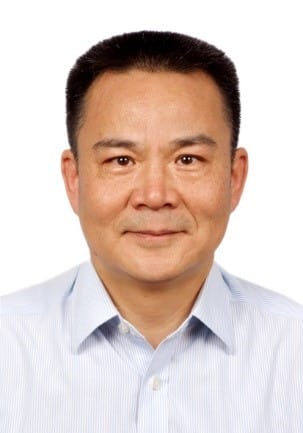How do you convert CO2 into jet fuel?
Wednesday 3rd May 2023, 12.30pm
Increasing levels of CO2 in our atmosphere are a big cause for concern. So what if we could find a way to not only remove some CO2 from the air, but turn it into something useful too? That’s exactly what Dr Tiancun Xiao and his team have been working on…and they’ve found a way to turn CO2 into jet fuel!
Emily Elias: Imagine a world where you could take CO2 from the air and turn it into something useful. Well, thanks to the power of chemistry, we’re there. Well, kind of there. There, with asterisks. On this episode of the Oxford Sparks Big Questions podcast, we’re asking, “How do you convert CO2 into jet fuel?”
Hello, I’m Emily Elias, and this is the show where we seek out the brightest minds at the University of Oxford and we ask them the big questions. And for this one we have found a researcher who is a master of chemical bonds, both in breaking them and reassembling them.
Tiancun Xiao: So I’m Dr Tiancun Xiao. I was trained as a chemist. I used to work in the Inorganic Chemistry Laboratory, Oxford University, as a senior research fellow. So my main work is on research and the development of new catalysts for better and high efficiency of the chemical process.
Emily: Okay, so you’re going to be my chemistry teacher and hold my hand through this. You’ve promised me. So let’s just start at the beginning. Before we get to how you turn CO2 into jet fuel, why would you want to turn CO2 into jet fuel?
Tiancun: Oh, clearly we are facing a serious climate crisis. We see now the extreme weather. Certainly it’s the increase in human activities why, in the last hundred years we have been continuously using more and more fossil fuel. You know, combustion engine, boiler, power station. The human being emits such a big amount of carbon dioxide in the air which is now causing the global warming.
So CO2 is causing trouble. Because in the past, before the industrial revolution, CO2 in air concentration is about 200ppm, called the part per million. Now it’s nearly 400 parts per million, ppm. So this is really staggering. We are facing a serious climate crisis. So we must reduce CO2 emission.
Emily: So, if you’re wanting to change CO2 on a molecular level to something else, how do you do that?
Tiancun: Okay. So CO2 is a very stable molecule. Very low activity. And it needs hydrogen to react with CO2. In theory, they can react. Like a boy and a girl that wants dating. In theory they can, but because they’re separated by a river you have to build a bridge for them to meet. So the catalyst is like a bridge and you must find the right catalyst for CO2 to react with hydrogen to make aviation fuel or other chemicals. So this catalyst is very similar to a bridge. You must find a very good catalyst for CO2 to be used.
Emily: Okay, so the catalyst is the bridge. How do you go about finding a catalyst?
Tiancun: Oh, a catalyst is a material I should say. In theory, from last 200 years’ research, we know that some catalysts can activate CO2 and then enable it to react with hydrogen. But the catalyst can make CO2 turn into methane, another greenhouse gas, if you don’t make a catalyst properly. So our target product is aviation fuel. It’s like eight carbon linked together. Methane is a one single carbon molecule.
So you must build the right catalyst. So this needs lots of experimental work. In theory, you say, “Okay, over this surface, over this bridge, a boy and a girl can meet. But if the bridge is too narrow, if they can’t walk through the bridge, they still can’t meet.” That’s like how can you make the catalyst? You must make the right catalyst through experiment.
Emily: So, is it literally trial and error to figure out what catalyst will make the bridge between the boy and the girl on the other side of the river or the CO2 and the hydrogen on the other side of the river?
Tiancun: More or less. Certainly with much more [accumulated 0:05:32] work in the last century we do have some theoretical guidance. But still, if you can’t- because this catalyst preparation in a nanoscale, not like anything in a mesoscale or like a microscale. Usually you can under a microscope do that. This under like a nanoscale. So sometime it’s really- in theory you know that this bridge you want [first is a 0:06:06] ___ or like the high. But in the preparation you still have to do lots of experiment. Yes, trial and error. You’re right.
Emily: This is all theoretical until you get to that magical place to trial and error that finds something that works. How hard is it to take something from theoretical to very practical and you can, say, turn CO2 into jet fuel?
Tiancun: Certainly in theory, in chemistry we call it thermodynamic. That mean that ___ like the potential if they are like a boy and a girl they are attracted, they have an intention to meet up. So thermodynamically that could work, but that could work in a different way. If I say, like, as a [ ___ 0:06:58], if you can’t build the right catalyst, they will go a wrong way, wrong product, or they even can’t react.
So we have done lots and lots of work and [design] from our ___ scale the right catalyst surface. The surface become where the CO2 and the hydrogen meet up and how to get there. Because CO2 is a single carbon molecule, we want to get aviation fuel which you need an eight carbon molecule or above. So we needed a carbon link up.
So it’s not easy, because hydrogen is inflammable. When you do you need a high pressure. You need to give them the right path for them to react. They can’t meet if you don’t have the right catalyst there. So it’s really taken a bit longer journey, nearly 14 years, for us to come to this stage.
Emily: But you’ve managed to do this, correct? You have managed to be able to convert CO2 that is floating around in the air and at the end come out with jet fuel?
Tiancun: Yes, we think we are lucky. Certainly based on my last 30 year work experience together with Professor Peter Edwards. There is also other way people do that. People are saying, “Okay, they can use two steps.” So because some other people before us, many industrial practice, they try to make jet fuel from CO2 and hydrogen using two-step process.
That’s again like this bridge example. They may add a lot of stone somewhere where no water, then they go another step, two-step process. They change the CO2 to CO first. CO2, you know, to CO. Then CO plus hydrogen called syngas, which could be used for making aviation fuel or wax.
So CO plus hydrogen to aviation fuel or wax is a mature industry. But CO2 plus hydrogen go to CO with step and they were being industrialised before. So the reason why we think we’ve got much better efficiency, we use one step, CO2 plus hydrogen, over our catalyst. One catalyst do [multi 0:09:41] function to make. So this will save energy input, save capital and make the product more competitive.
Emily: I mean, it almost sounds like magic. As somebody who doesn’t work in this world of chemistry, how did it feel when you were able to figure out what catalyst, what bridge, you needed to make and actually make CO2 into jet fuel?
Tiancun: Oh, the emotion in the end certainly starts out exciting. Because in the past people said we must- before us, you know, the concept called CCUS: carbon capture, utilisation and storage. The Ministry of Industry say, “Okay, while we use fossil fuel we just capture carbon and store it buried underground.” Because they think CO2 utilisation is almost impossible and not economical.
So after our one-step process when we make this jet fuel and hydrocarbons, we think that we changed the whole landscape of the industry. And people will now, after the last five years you see the whole industry change, turn to use CO2 rather than just bury it.
Emily: So what’s the current status of the project? Are you able to do this at a large scale?
Tiancun: In [large 0:11:14] scale we are working in principle, it’s doable. Then how can you burn ___ efficiently? How can you make this process develop for industrial? You make not one girl and boy, you make many girls and boys [dating] through this. So we scale up the process. Then we say how can we make this catalyst more efficient? Because it’s industrial, how to avoid the traffic jam. So all being scaled up, all being under development stage. But this certainly is a step change.
Emily: So you’ve got to be optimistic, though?
Tiancun: I think not only we optimistic, the whole human beings should feel optimistic about the future, particularly for the future generation. And we say that because they need to have a bright future, a safe future. Because when we look back, renewable energy now becoming more and more supply. But renewable energy now we say the hydrogen economy. Look back last 20 years, the hydrogen cost reduced or decreased continuously.
So once you get hydrogen, you paste the way to use hydrogen to react with CO2 to form hydrocarbons like aviation fuel or chemicals or plastic. Which, if we can use surface carbon, if we don’t dig up or stop mining the fossil fuel underground, then the CO2 won’t build up in air. So we’ve got like net zero world.
Emily: Are you very proud of yourself? Because I feel like you should feel proud.
Tiancun: I think certainly it’s team work. We are all proud with our development. We think not only for us, also for the human being. We feel we should be proud for that, but certainly we still have a long way to go to show that industrial scale it’s working, it’s much more efficient.
Emily: This podcast was brought to you by Oxford Sparks from the University of Oxford, with music by John Lyons and a special thanks to Dr Tiancun Xiao.
Tell us what you think about this podcast, you can find us on the social medias, we are @OxfordSparks. We also have a website: oxfordsparks.ox.ac.uk. I’ve said that once, I’ve said it twice, said it a thousand times.
I’m Emily Elias, bye for now.
Transcribed by UK Transcription.





